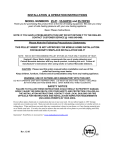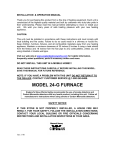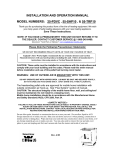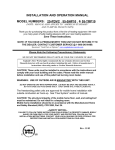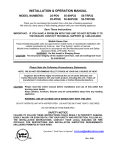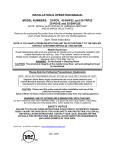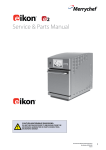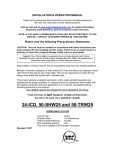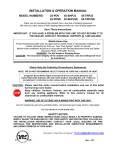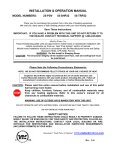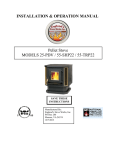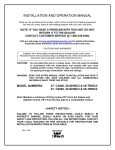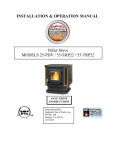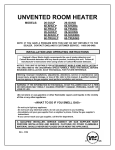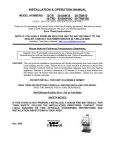Download England's Stove Works 25-PAF Owner's Manual
Transcript
INSTALLATION AND OPERATION MANUAL
25-PAF, 55-SHP25 AND 55-TRP25
Thank you for purchasing this product from a fine line of heating equipment.
We wish you many years of safe heating pleasure.
NOTE: IF YOU HAVE A PROBLEM WITH THIS UNIT DO NOT RETURN IT TO
THE DEALER. CONTACT CUSTOMER SERVICE @ 1-800-245-6489.
Save these Instructions.
Please Note the Following Precautionary Statements:
WE DO NOT RECOMMEND PELLET UNITS AS YOUR ONLY SOURCE OF HEAT.
England’s Stove Works highly recommends the use of smoke detectors and
Carbon Monoxide detectors with any hearth product, including this unit. Follow all
manufacturer’s instructions when using smoke or Carbon Monoxide detectors.
This unit is designed as an Add-On Furnace, to supplement your existing system.
It is not designed to heat your home from a cold start.
NOTE: THIS STOVE IS NOT MOBILE HOME APPROVED
CAUTION: These units must be installed in accordance with these instructions and
comply with your local building and fire codes. Please read this entire manual before
installation and use of this pellet fuel burning add-on furnace.
Keep children, furniture, fixtures and all combustibles away from any heating appliance.
WARNING: USE OF OUTSIDE AIR IS MANDATORY WITH THIS UNIT.
DO NOT OPERATE UNIT WITH HOPPER OPEN. LID MUST BE SHUT AND SECURED TIGHTLY.
DO NOT OPERATE WITH DOOR OPEN, OPEN DOOR ONLY WHEN LIGHTING.
→SAFETY NOTICE←
FAILURE TO FOLLOW THESE INSTRUCTIONS COULD RESULT IN PROPERTY
DAMAGE, BODILY INJURY OR EVEN DEATH. FOR YOUR SAFETY AND PROTECTION,
FOLLOW ALL THE INSTALLATION INSTRUCTIONS. CONTACT YOUR LOCAL
BUILDING OR FIRE OFFICIALS FOR RESTRICTIONS AND INSTALLATION
INSPECTIONS IN YOUR AREA.
Rev. 1/06
A letter from our Technical Support department:
Thank you for purchasing this fine product from England’s Stove
Works!
England's Stove Works was started, and is still owned by, a family that
believes strongly in a "Do It Yourself" spirit – that’s one reason you
found this product at your favorite “Do It Yourself” store.
We intentionally design and build our stoves so that any homeowner
can maintain his or her unit with basic tools, and we're always more than
happy to show you how to do the job as easily and as inexpensively as
possible.
From our free, downloadable service sheets; to our Pellet Service Video;
to our new "wizard-style," click-through Troubleshooting guide on our
web site, we have always tried to help our customers stay "heat-ready,"
especially when oil and electricity prices continue to skyrocket.
Please look at our vast Help section on our web site and call our
Customer Service department at (800) 245-6489 if you need any help
with your unit.
We are nearly always able to help “walk you through” any repairs,
problems or questions you may have.
PLEASE NOTE: While information obtained on our web site and through
our 800 number is always free of charge, there will be a service charge
incurred with any “on-site” repairs or maintenance that we may arrange.
Wishing you years of efficient, quality and “comfy” heating,
England’s Stove Works
Technical Support Department
www.englanderstoves.com
(800) 245-6489
IF YOU HAVE A PROBLEM WITH THIS UNIT DO NOT RETURN IT TO THE DEALER.
CONTACT CUSTOMER SERVICE at 1 (800) 245-6489.
IMPORTANT INFORMATION
1. Check local installation codes for your area.
2. Read and comply with the instructions in this manual.
3. This unit should be tested (dry run) before loading pellets.
4. Your stove is designed to burn Premium Hardwood Pellets. Pellets with a high ash
content will burn dirty and the unit will need cleaning more frequently.
5. Be sure your pellets are not damp or wet. Keep sawdust out of the unit.
6. Use 3” PELLET VENT PIPE with this stove and follow the manufacturer’s specifications
for installation and clearances. Even though this pipe interlocks it is a good idea to seal
all connections with high temperature silicone.
7. An outside combustion air connection is mandatory for this unit to work properly. Make this
connection using a 1 7/8” I.D. metal pipe (steel, aluminum or copper) and coupler. Be sure to
secure the pipe to the unit with aluminum tape or a clamp. Our part number PU-OAK
(Outside Air Kit) can be used. The outside end should be covered (screened) to prevent any
foreign matter from getting into the system.
8. Regularly inspect the ash build-up in the burn pot and, if any crust forms remove it from
the burn pot with a poker.
9. The ash in the burn pot should be removed regularly, depending on your burn rate. The area
to the right and left of the burn pot is for ash storage; keep the air holes in the burn pot clean
for a more efficient burn. You should also frequently check the exhaust system.
10. Keep pellets and all other combustible materials a safe distance from the stove.
11. This unit will require floor protection if it is installed on a combustible surface.
The minimum floor protector for this stove is 36” x 36” which should give you at least one
inch (1”) of protection at the rear, four inches (4”) on each side and six inches (6”)
minimum in the front of the unit.
12. Horizontal runs should not exceed four feet (4’) with a maximum vertical flue
height of thirty five feet (35’). At a height of fifteen feet (15’) the pipe should be
increased to 4” PELLET VENT PIPE.
13. This unit should be turned off and allowed to cool prior to cleaning. Any ashes should be
kept in an airtight metal container completely away from all combustibles and should not
be disposed of until they are completely cooled.
14. Read the instructions thoroughly concerning the various settings that are available
with the digital read-out control board.
Visit our web site at www.englandsstoveworks.com for helpful information,
frequently asked questions, parts & accessory orders and more.
Do not allow paint, chemicals or construction dust on or near your unit. Do not allow liquid or ANY
foreign materials on or inside your unit. Shut your unit down and cover it when painting, construction or
UNIT PREPARATION
similar activity is taking place. Wipe and clean your unit after any construction is done in your home, or if
any foreign material gets on or inside your unit. You may also need to remove the rear and side cover plates
to your unit (unplug unit first) and vacuum and clean the motors and inside of your unit.
Some dealers will prepare your unit for operation and even “dry run” it before delivery. If
this has not been done, you can follow the steps as listed below.
1.
Attach the spring handle to the door by turning it counterclockwise. Install the hopper
lid latches as illustrated by the drawing at the rear of this manual. Important: Latches
must be tight so that the top is sealed to prevent back-burn. Check to insure the baffle
is in place in the firebox.
2.
Test your 110-volt outlet for current and then plug in the unit. (We highly
recommend a surge protector for our pellet stoves).
3.
It is important to note that this stove is equipped with a dual auger system. The top
auger runs intermittently and drops pellets to the bottom auger; the bottom auger runs
constantly and simply pushes the pellets forward to the burn pot. The control board setting
determines the top auger feed rate.
4.
The stove has a digital read-out control board and is started by pressing the “ON”
touch pad. This will immediately start the upper auger, bottom auger and exhaust blower.
Pressing the arrows under “Heat Range” to a higher setting will make the top auger operate
for a longer period of time; pressing these arrows to a lower setting will make the top auger
operate for a shorter period of time. You may observe the top auger by opening the hopper
lid, and the bottom auger by opening the door to the firebox and looking in the burn pot. The
room air blower will start later as the stove reaches the pre-set blower temperature (see
“Control Board” section for further explanation).
FLUE SYSTEM
Caution: Follow the pipe manufacturer’s installation instructions and directions
for passing through combustible walls and ceilings. Check local codes in your area.
This unit is equipped with a negative draft system that pulls air through the burn pot and
pushes the exhaust out of the dwelling. If this unit is connected to a flue system other than
the way explained in this manual, it will not function properly. The manufacturer will not be
held responsible for damage caused by the malfunction of a stove due to improper
installation.
Pellet Vent Pipe
The UL approved pellet vent pipe is a twist lock system; however, it is still recommended
that high temperature silicone be used at each joint. Do not use “B” vent gas pipe or
galvanized pipe with this unit. The pellet pipe is designed to disassemble for cleaning and
should be checked several times during the burning season. Pellet vent pipe is not furnished
with the unit and must be purchased separately. (Contact us at 800-516-3636 for information
on our AC-3000 Through-the-wall kit.) Do not install a flue damper of any kind in this
system and do not connect this unit to a flue system serving another heating
appliance.
Through the Wall
To vent the unit through a wall, connect the pipe adapter to the exhaust motor adapter. If
the exhaust adapter is at least eighteen inches (18”) above ground level, a straight section of
pellet vent pipe can be used through the wall. Your dealer or our factory should be able to
provide you with a kit that will handle most of this installation, which will include a wall thimble
that will allow the proper clearance through a combustible wall. Once outside the structure, a
three-inch (3”) clearance should be maintained to the outside wall and a clean out tee should
be placed on the pipe that extends through the wall. We recommend a minimum of three feet
(3’) of vertical pipe with a 90-degree turn away from the house. At this point a one-foot (1’)
section should be added with a horizontal cap which would complete the installation.
A wall strap should be placed just below the last 90-degree section to make the system
more stable. If you live in an area that has heavy snowfall it is recommended the installation
be taller than three feet (3’) to get above the snow drift line. This same installation can be
used if your stove is below ground level by simply adding the clean-out section and vertical
pipe inside until ground level is reached. With this installation you have to be aware of the
snowdrift line, dead grass and leaves. We recommend a three foot (3’) minimum vertical rise
on the inside or outside of the house.
The through-the-wall installation is the least expensive and simplest installation. Never
terminate the end vent under a deck, in an alcove, under a window or between two windows.
Call (800) 516-3636 to inquire about the AC-3000 Pellet Vent Kit.
Through the Ceiling
When venting the stove through a ceiling, the pipe is connected the same as through the
wall, except the clean-out tee is always on the inside of the house. You must use the proper
ceiling support flanges and roof flashing that are supplied by the pipe manufacturer – follow
the pipe manufacturer’s directions and the illustration in this manual. It is important to note
that, if your vertical runs of pipe are more than fifteen feet (15’), at this point the pellet vent
pipe size should be increased to four inches (4”) in diameter. Do not exceed four feet (4’) of
pipe on a horizontal run; do attempt to use the least number of elbows for your flue system. If
an offset is used, it is better to install a 45-degree elbow whenever possible.
Existing Flue System
If you are replacing a wood stove with a pellet unit, the chimney or pipe should be cleaned
thoroughly before proceeding with the installation. The flue system should be either masonry
or a UL approved pre-manufactured Class A flue system. The flue thimble or pipe will be
either six inches (6”) or eight inches (8”), and the proper reducer (3” to 6” or 3” to 8”) can be
purchased or ordered by your local dealer. Connect a three inch (3”) tee with clean-out to the
pipe adapter — seal this with a high temperature stove cement, then extend the pipe to the
installed reducer at your thimble. If the thimble is in the ceiling the pipe will go straight up, but
if the thimble is in the wall another 90-degree elbow will be required to make the connection.
Outside Air
Outside air is mandatory for this unit to operate properly. This unit has been designed and
tested with this connection, because so many homes are airtight and there is not adequate
combustion air available from inside the home. The air intake pipe is located at the rear of
the burn pot and measures one and one half inches (1 ½”) in diameter. This connection can
be made with 1 7/8” metal pipe and coupler, and should exit through the wall (see “Important
Information” section). Our part number PU-OAK (Outside Air Kit) can be used. Be sure to
secure the pipe to the unit with aluminum tape or a clamp. The outside end of the pipe
should be covered (screened) to prevent foreign matter from entering the system. If your unit
is located below ground level, you will need to run the pipe up and then outside the dwelling.
If your run of outside air pipe is more than 6’ (six feet), you must increase to 3” diameter pipe.
FLOOR AND WALL PROTECTION
Floor Protection
If your floor is constructed of a non-combustible material such as brick or concrete there is
no need for floor protection. If your floor is constructed of a combustible material such as
hardwood, linoleum or carpet, then you will be required to use floor protection between the
unit and the combustible. The protection that is chosen should be UL equal, and should be
large enough to provide at least one inch (1”) behind and four inches (4”) on both sides of the
stove. The clearance at the door of the stove should be at least six inches (6”). This add-on
furnace pellet unit will need a 36” x 36” floor protector.
Wall Protection
From the rear and sides of this stove only six inches (6”) of clearance is required to
paneling, wallpaper or sheet rock. The pellet vent pipe would require the standard three
inches (3”) clearance as recommended by the manufacturer. Normally additional wall
protection is not required with this type unit.
OPERATING INSTRUCTIONS
CAUTION: Do not operate with the door open; open door only when lighting.
This stove has an induced draft system and is designed to operate continuously, as
frequent shutdown is not required. The digital control board allows the stove to operate by a
time relay-delay system; this system controls the top auger feed rate by operating for a
predetermined number of seconds, while the bottom auger operates constantly. The setting
of the heat range touch pad will control the heat output and the amount of pellets the unit will
burn. Note: This stove is using solid fuel and will not restart automatically.
Horizontal Feed System
This unit has a top and bottom auger separated by four inches (4”), and a 1 RPM motor
drives each auger. The top auger drops pellets to the bottom auger tube, and the bottom
auger pushes the pellets forward to the burn pot. This assures there is no build up of fuel in
the bottom auger tube. As pellets enter the burn pot the combustion air is drawn across the
fuel.
START- UP PROCEDURE
1.
2.
3.
4.
Verify the hopper is clean & free of foreign matter, and there is current at your outlet.
Load the hopper with two bags of pellets (80 lbs. total).
Close hopper lid and secure the latches.
Place a handful of pellets in the burn pot, spread a small amount of fire starter over the
top and ignite the pellets. Wait a few minutes before closing the door and pressing the
“ON” touch pad — if the door is closed before the pellets are burning thoroughly, the
exhaust blower could put out the fire.
Recommended fire starter materials: Wax-impregnated wood chips, cardboard cubes
or liquid fire starter designed for pellet stoves. Never use kerosene, gasoline, diesel
fuel or any other flammable liquid to start the fire.
5. Check to be sure the flame is sustaining itself and is increasing as it involves the fuel
bed. If the flame does happen to go out, repeat the above sequence.
First Fire: Adjust the heat range to a “5” setting and allow the stove to operate in
this manner for approximately three (3) hours or more, if needed. This will allow the
stove to “cure out” as the paint and oils from the manufacturing process burn off. We
recommend that you open doors and windows in your dwelling during this process.
Subsequent Cold Starts: We recommend that you operate the unit on a “5” setting
until the convection (room air) blower begins to operate.
SHUT DOWN PROCEDURE
WARNING: NEVER SHUT DOWN THIS UNIT BY UNPLUGGING IT FROM THE
POWER SOURCE. Refer to the following instructions.
Press the “OFF” touch pad to put the stove in the shut down mode. At this time the red
light above the pad will illuminate. The instant this is done, the top auger will stop feeding
pellets to the bottom auger, but the room air blower, exhaust blower and the bottom auger
will continue to operate. When the internal temperature of the unit drops to 95 degrees the
room air blower will stop operating; the exhaust blower and the bottom auger will cease to
operate when the temperature drops to 90 degrees. The red light will now shut off and the
unit will be completely down. Keep in mind that the hotter the unit is operating, the longer it
will take for the stove to complete the shut down cycle.
Note: If the room temperature stays above 70 degrees, the unit will remain in the shut
down mode for 54 minutes, regardless of the temperature at the heat sensor. If the stove
stays on this long and you are sure the fire is out, the cord can be unplugged from the outlet.
After approximately 10 seconds the unit can be connected to the power source and the
board will be reset.
DAILY OPERATION
Refueling the Unit
Always press the “OFF” pad before refueling. This unit has a 80-pound hopper and should
be filled when the hopper level drops to three or four inches (3” or 4”).
Note: The hopper will be warm; therefore, you should always use some type of hand
protection. Never place your hand near the auger while the stove is in operation.
Note: Be sure to close the hopper securely before re-firing.
Power Outage
Important: This stove is equipped with a vacuum safety switch. If the power to your stove is
interrupted for more than three minutes, but less than 18 minutes, the unit will shut down and an
error code will show in the “Heat Range” window of the Control Board. At this point, you may press
the “On” button and the unit will automatically resume operation; however, if the power is off for
more than 18 minutes, the unit will have to be re-started completely (see “Start-Up Procedure).
NOTE: The unit will also shut down in the event of Combustion Blower failure; if this is the case,
the unit will not re-start and you must contact Customer Service at (800) 245-6489. It is very
important for the unit to be vented properly (outside air), as the natural draft is needed to clear the
smoke from the stove. Also, do not open the hopper lid. This may cause fire to burn in the hopper.
If the power is off for more than 18 minutes, use a poker or a scooper to place burning pellets in
the sides of the firebox and remove them from the burn pot. When power is restored, press the
“ON” button and let the unit run for approximately 5 minutes, then press the “OFF” button – this will
remove any pellets from the upper and lower auger systems. After the unit has cooled, use a
vacuum to remove all remaining pellets from the firebox and burn pot area; you may then restart
your unit.
Fire Outage
If the fire in the burn pot goes out, the stove will automatically go into the shut down mode.
Fuel Outage
If the unit should run out of pellets or the pellets happen to bridge in the hopper, the
temperature of the heat chamber will fall below 90 degrees and the stove will go into the shut
down mode.
ASH REMOVAL AND DISPOSAL
Daily Ash Maintenance
If there is fuel in the hopper, press the “OFF” pad and allow the unit to burn for
approximately five (5) minutes in the shut down mode prior to opening the front door. Use a
long-handled screwdriver or a long-handled putty knife to scrape off any build-up or crust in
the burn pot area. This can be pushed to the left or right into the ash storage area until the
weekly ash removal.
Weekly Ash Removal
Shut the unit down by pressing the “OFF” pad and allowing the unit to go through the complete
shut down cycle. Allow the unit to completely cool down and then remove the ashes by pushing them
into the ash pan and dumping them. {NOTE: The 3” x 9” Ash Dump Door (the flat, rectangular piece of
steel with a handle that is located directly above the ash pan) must be pulled out so the ashes from
the burn pot area can be dropped into the ash pan. Remember to replace it after dumping the ash
pan and before restarting the stove.} The ashes should be placed in a non-combustible container with
an airtight lid and should always be placed on a non-combustible surface or on the ground until
completely cooled and free of hot cinders.
Once the ash is removed, the burn pot should be given a thorough inspection. Remove the burn pot
wear plate and check for any build-up in the front of the burn area. Clean out all air holes (if necessary
a 1/8” drill can be used) — these air holes should be kept clean, as they supply combustion air under
and around the pellet fuel.
Monthly Ash Removal
The large baffle plate (13” x 13”) that hangs behind the fire should be removed monthly.
This can be done by lifting up the plate and pulling it out. The area behind this plate should
be cleaned thoroughly and then the plate placed back in its original position. The burn pot
assembly should also be thoroughly cleaned, and the wear plate should be removed and
cleaned. Before replacing the wear plate, clean the burn box thoroughly.
Annual Cleaning
The stove and the flue system should be given a complete cleaning at the end of the
heating season. Remove the burn pot assembly, clean it thoroughly, and re-install it (refer to
Exploded View); this will require new gasket for the burn pot. Be sure to tighten the set
screws when you replace them, but do not over-tighten. In addition to the cleaning
mentioned earlier, the exhaust blower should be removed annually and the blower tube
vacuumed of any ash build up. When cleaning or replacing the blower a new gasket (Part #
PU-CBG) should be added between the blower flange and the steel exhaust tube.
Soot and Fly ash: Formation and Need for Removal – The products of combustion will
contain small particles of fly ash. The fly ash will collect in the exhaust venting system and
restrict the flow of flue gases. Incomplete combustion, such as occurs during startup,
shutdown, or incorrect operation of the room heater will lead to some soot formation which
will collect in the exhaust venting system. The exhaust venting system should be inspected
at least once every year to determine if cleaning is necessary.
MAINTENANCE
CAUTION: UNPLUG THIS UNIT PRIOR TO ANY SERVICE WORK.
Parts Orders Only: (800) 516-3636
Questions: (800) 245-6489
Note: To do any service on this unit the rear steel access panel must be
removed. Eight (8) screws hold this panel to the rear of the stove.
Auger Motors
The auger motor and gearbox are one complete assembly (PART #PU-047040) and can
be removed by disconnecting the power leads and loosening the (5/16” head) set bolt in front
of the assembly. This bolt tightens down on the flat side of the gear shaft and locks the gear
shaft and auger shaft together — once the bolt is loosened, the entire assembly will slide
from the locking collar. There are two motor assemblies on this unit and both rest on a shelf
when not in operation. When replacing a motor the assembly should always be placed on the
shelf prior to starting the stove.
Auger Bearings and Auger Shafts
The auger bearings (PART #PU-UCF204-12) are a sealed unit and do not require
lubrication. To replace the top auger all the fuel must be removed from the hopper, as well as
the top auger motor assembly (see above). Once this is done the four bolts that hold in the
bearings can be removed. At this time, the complete auger assembly can be
pulled from the stove. Loosen the two (2) set screws with a 9/64” allen wrench, which will
disconnect the bearing from the shaft. The bearing and auger shaft can be replaced by
reversing this procedure. When placing the auger bearing and shaft assembly back into the
unit, always tighten the four bolts in a diagonal pattern to assure the bearings are aligned
properly. Follow the same procedure to work on the bottom auger, with the exception that the
pellets do not have to be removed from the hopper.
Convection Blower
The convection blower (room air blower) — PART #BM-1376 — is located under the burn
pot of the unit and can be removed by disconnecting the power leads and removing the four
screws. Once this is done, the blower should slide out the rear of the unit. Reverse this
procedure to install a new room air blower.
Combustion Blower
To clean or replace the combustion (exhaust) blower — PART #PU-076002 — the power
leads and the pellet vent pipe must be disconnected. Next, remove the four screws that hold
the blower to the steel exhaust tube and the entire blower should release from the stove. The
blower impeller, blower tube and the steel blower exhaust tube on the stove should be
brushed and vacuumed. When cleaning or replacing the blower a new gasket should be
added between the blower flange and the steel exhaust tube.
Gaskets
This unit comes with a 3/4” rope gasket around the door, which should be replaced every
two years. To replace the door gasket (Part #AC-DGKC), the old gasket must first be
removed entirely — this may require you to scrape the old material from the channel before
adding the new cement. Once this has been done the door should be closed and latched for
twenty-four hours to allow the adhesive to harden. If you are replacing the window gasket
(PART #AC-GGK), the new gasket already has adhesive on it. Remove the paper on the
adhesive side and place the gasket around the outside edge of the glass, by forming a “U”
with your fingers and running the new material around the window. The door and window
gasket can be ordered from your local dealer or from the factory.
Finish
This new unit has been painted with 1200 degree Metallic Paint (PART #AC-MCSP) that
will retain its original look for years. If the unit should get wet and rust spots appear, they can
be sanded with plain steel wool and repainted. We recommend this paint, as others may not
adhere to the surface or withstand the high temperatures.Glass
This unit has a 9” x 9” ceramic glass (Part #AC-G9) in the viewing door. If this glass
becomes cracked in any area, the unit should be shut down and the window replaced. The
glass can be ordered from your dealer or from the factory.
You may order parts and options on our web site: www.englandsstoveworks.com ,
or by calling (800) 516-3636.
Our web site also offers service instructions that can be printed or viewed as video.
THE FUNCTION OF THE ADD-ON FURNACE
The Add-On Furnace is designed to be a supplemental hot air heating system that will
connect to your existing heating system. The furnace will operate independently of your
existing system while using the same hot air ducts that your present furnace uses. The
furnace comes standard with a 850 CFM blower that pushes hot air up both sides and across
the top of the unit through an inner-duct chamber built around the firebox. The heated air
exits the unit through a six-inch outlet located on the top, near the front of the furnace. The
six-inch pipe connected at this exit will route the heated air into your duct system.
HOT AIR HOOK-UP
You first need to position your unit as close to the flue connector as possible and install your
flue pipe. Once this is done, you may hook your hot air outlet into your ductwork.
Located on the top, near the front of the unit is a six-inch opening for the mounting of the flue
collar. When mounting this part be absolutely sure it is fastened securely to the opening, as
this will be the hot air exit. Thirty gauge or thicker pipe should run from the top of the furnace
to the hot air trunk line of your existing hot air system. Using the least possible amount of
pipe will help the heat transfer to your duct system. Cut a six-inch diameter hole in the main
trunk line of the furnace duct, which is usually located on the top of the central furnace. Slide
the six-inch pipe from the wood furnace into the
hole and seal the connection with duct tape.
Thirty gauge or thicker black pipe should be used
for the first two feet and then thirty gauge or
thicker galvanized pipe can be used to connect
to the existing furnace duct. Sheet metal screws
should be used to secure each joint of pipe and
Air Flow
an aluminum heat resistant tape can be wrapped
around each joint to give an airtight seal.
NOTE: This versatile, all-purpose heater can also
be used, for example, in a garage or shop
environment without ductwork – simply attach a 6”
elbow directly to the hot air outlet of the furnace,
and point the elbow in the direction you wish to
direct the air flow.
NOTE: Install a 6” 90 degree elbow
inside Central Furnace plenum or
ductwork so that air flow from central
furnace will not be directed back into
the add-on furnace. (A 7” hole will be
required for this installation.)
Installation Notes
Flashing
12” Min.
(Use
End
Cap)
3” Min.
Clearance
3”
Min.
Outside Air
Inlet: Use
1 7/8” I.D.
Pipe (see
manual)
NOTE:
1.
2.
3.
4.
5.
If 3” flue pipe exceeds 15’ in length, increase to 4” flue pipe for remaining
flue connections.
Total flue length should not exceed 35’.
Horizontal run not to exceed 4’.
Floor protector required: Min. size 36” x 36”.
Outside Air is Mandatory.
3” Min.
Clearance
Low Burn:
Medium Low:
Medium High:
High Burn:
Recommended Heat Ranges:
Heat Range setting: 1
Room Air Blower setting:
Heat Range setting: 2 – 3
Room Air Blower setting:
Heat Range setting: 5 – 8
Room Air Blower setting:
Heat Range setting: 9
Room Air Blower setting:
* NOTE: Blower Speed should match Heat Range.
CAUTION:
NOTE: The bottom 3 buttons are
pre-set at the factory and do not
need adjustment. Call Service at
(800) 245-6489 if you have
questions or problems.
This Vacuum Switch
only for use on 25PDV, 25-PI, 55SHP22, 55-SHP20,
55-TRP22
and 55-TRP20
1
*
*
9
THE CONTROL BOARD
The control board (PART #PU-CB98) is a digital read-out board. This board offers a wide
variety of settings to operate the unit. Again, the bottom controls are preset at the factory
and should not require any alteration on start-up of the unit (see “Unit Preparation” section
for information on setting the Heat Range). This part can be removed from the unit by
loosening the two screws on the outside of the stove, and then pulling it back to the inside of
the stove. The rear access panel should be removed prior to removing the control board.
THERMOSTATS
REMOTE: There is now a Remote Thermostat (Part # AC-3001) available for your pellet
stove. It comes with everything necessary for quick installation, and has many features to
allow remote control of your unit.
WALL: Also, an external wall thermostat (such as our Part # GU-1E30-914) can be used on
our pellet units as long as it is a 24-volt that works with millivolt systems. After unplugging the
unit, locate the jumper wire (J-3) on the bottom of the control panel. The two screws should
then be loosened and the jumper wire removed from the board. Next, the two thermostat
lead wires should be slipped into these openings and the screws tightened; the jumper wire
should be saved for future operation without a thermostat.
The unit will operate differently once the wall thermostat is connected -- we recommend
the stove control board be set at a minimum of “5” on the Heat Range while using the
thermostat. This will allow the stove to run around a medium setting and drop back to a lower
setting when the thermostat is not calling for heat. Refer to the section on “Start-up
Procedure” for information on cold starts.
Call (800) 516-3636 or log onto www.englandsstoveworks.com to inquire or order these.
Hopper Lid Latch (2 per unit)
Important: Hopper Lid Latches must be checked periodically
and kept tight so the top is sealed to prevent back-burn.
Have this information on hand if you phone the factory or your dealer regarding this product.
Retain for your files:
Model Number __________________________
Date of Purchase ________________________
Date of Manufacture _________________ Serial #_____________________
LIMITED 5 YEAR WARRANTY FROM THE DATE OF
PURCHASE TO THE ORIGINAL OWNER
The manufacturer extends the following warranties:
Five Year Period:
1. Carbon steel and welded seams in the firebox are covered for 5 years against splitting.
2. The cast iron door and hinges are covered for 5 years against cracking.
One Year Period:
3. Component parts such as the hopper, auger burn pot, baffle plate, auger shafts,
auger bearings, and fasteners are covered for 1 year against cracking, breakage
and welded seams from separating.
4. Electrical components, accessory items, glass and the painted surface are covered
for 1 year from the date of purchase.
Conditions and Exclusions:
Damage from over-firing will void your warranty.
This warranty does not apply if damage occurs because of an accident, improper handling,
improper operation, improper installation, abuse, or unauthorized repair made or attempted
to be made.
The manufacturer is not liable for indirect, incidental, or consequential damages in
connection with the product including any cost or expense providing substitute equipment or
service during periods of malfunction or nonuse.
All liability for any consequential damage for breach of any written or implied warranty is
disclaimed and excluded. Some states do not allow the exclusion or limitations of incidental
or consequential damages, so the above may not apply to you.
Procedure:
Purchaser must give notice of claim of defect within the warranty period and pay
transportation to and from a service center designated by the factory. The dealer from which
the unit was purchased or the factory, at our option, will perform the warranty service.
Other Rights:
This warranty gives you specific legal rights, and you may also have other rights, which may
vary from state to state.
NOTE: THIS WARRANTY IS NULL AND VOID IF YOU DO NOT RETURN THE ATTACHED
WARRANTY REGISTRATION WITH A COPY OF THE SALES RECEIPT
WITHIN 30 DAYS FROM THE DATE OF PURCHASE.
WARRANTY IS NOT TRANSFERABLE
ACCESSORIES and REPLACEMENT PARTS LIST
FOR 25-PAF, 55-SHP25 and 55-TRP25
OPTIONS:
AC-3000
3” PELLET VENT KIT
AC-3001
REMOTE THERMOSTAT
AC-106-P/SH-106-P
BRASS WINDOW TRIM
AC-103
BRASS LIP TRIM FOR ASH APRON
GU-1E30-914
WALL THERMOSTAT
REPLACEMENT PARTS:
AC-GGK
GLASS GASKET KIT
AC-DGKC
DOOR GASKET KIT
AC-G9
9” X 9” CERAMIC GLASS (W/GASKET)
AC-SH
DOOR SPRING HANDLE
AC-MCSP
HI-TEMPERATURE CHARCOAL PAINT
PU-047040
1 R.P.M. AUGER MOTOR
PU-076002
COMBUSTION (EXHAUST) BLOWER
BM-1376
850 CFM CONVECTION BLOWER
PU-CB98
DIGITAL CONTROL BOARD
PU-62-40-151-2
Hopper Lid Latch (2002 and later Models; for
earlier models order PU-103-50)
PU-AF6T
TOP AUGER SHAFT W/FLIGHTING
PU-AF11B
BOTTOM AUGER SHAFT W/FLIGHTING
PU-BP98
BURN POT ASSEMBLY
PU-UCF204-12
AUGER BEARING
PU-2X570
¾” I.D. LOCKING COLLAR
All parts listed above can be ordered from our factory at 1-800-516-3636, or by visiting our
web site: www.englandsstoveworks.com .
If you have any questions please contact our Customer Service Department.
Customer Service Department
[email protected]
P.O. Box 206
(Parts Orders ONLY: 800-516-3636)
Monroe, VA 24574
(Questions: 800-245-6489)
(Fax: 434-929-4810)
Pellet Stove Exploded View
TROUBLE-SHOOTING GUIDE
WARNING: TO AVOID ELECTRICAL SHOCK ALWAYS DISCONNECT THE UNIT FROM
THE POWER SOURCE BEFORE ATTEMPTING ANY REPAIR. IF THIS GUIDE DOES NOT
CORRECT THE PROBLEM CALL YOUR LOCAL DEALER OR CUSTOMER SERVICE AT
1-800-245-6489.
.
Cause
Solution
Problem
1. Auger not turning
1. Loose set screw
2. Bad gear motor
3. Foreign matter in auger
4. Vacuum sensor (Top Auger)
1. Tighten setscrew on collar
2. Replace auger motor
3. Remove pellets and object
4. Check exhaust blower
2. Smoke smell or dust in house 1. Improper exhaust connection 1.Check all connections for leaks
especially the exhaust blower
connection; Seal with silicone,
hose clamp or aluminum tape
3. Room air blower not operating 1. Loose sensor
2. High “ON” temperature
1. Tighten connection on sensor
2. Adjust temperature lower
4. Exhaust blower not operating 1. Loose connection
2. Bad blower
3. Bad vacuum sensor
1. Check connection at c/board
2. Replace blower
3. Replace vacuum sensor
5. Lazy fire
1. Control board settings
2. Bad exhaust blower
3. Excessive pellet moisture
4. Excessive ash
5. Low quality pellets
1. Review board settings
2. Replace blower
3. Keep pellets inside
4. Remove baffles; Clean unit
5. Use premium hardwood pellets
6. Blown fuse (4 AMP)
1. Power surge
3. Electric motor shorting or
bound up
1. Replace fuse; use surge
protector
2. Check for exposed or frayed
wire and loose connections
3. Check motors and blowers
for obstructions or lock-up
7. High pellet consumption
1. Low quality pellets
2. Board out of adjustment
1. Use premium hardwood fuel
2. Check c/board settings
8. Squeaking noise
1. Build up in tube
2. Improper auger alignment
3. Blower noise
1. Remove auger and clean
2. Re-align auger
3. Remove and oil blower
9. Pinging or rattling noise
1. Foreign material
2. Loose set screw
1. Check blower for material
2. Check impeller blower screw
10. Unit shuts down in
30 to 40 minutes
1. Loose heat sensor
1. Check stove connection
2. Control board settings
2. Check settings; always start
unit on “5” to “9”setting
2. Exposed wire
Manufactured By:
England’s Stove Works, Inc.
P.O. Box 206
Monroe, VA 24574
(800) 245-6489 Questions/Problems
(434) 929-4810 Fax
www.englandsstoveworks.com
WARRANTY REGISTRATION
Purchased by (Name) ______________________________________________
Address _________________________________________________________
City ________________________ State __________ Zip _________________
Telephone _______________________________________________________
Email (Optional) ___________________________________________________
DEALER INFORMATION
Purchased From (Dealer) ___________________________________________
Address _________________________________________________________
City ________________________ State __________ Zip _________________
UNIT INFORMATION
Model Number _____________________ Purchase Date* _________________
Serial Number _____________________ Mfg. Date ______________________
*A copy of your store receipt must accompany this registration form.
IMPORTANT NOTICE
THIS REGISTRATION INFORMATION MUST BE ON FILE FOR THIS WARRANTY TO BE VALID.
PLEASE MAIL THIS INFORMATION WITHIN THIRTY (30) DAYS FROM THE DATE OF PURCHASE.
Mail To:
England’s Stove Works, Inc.
Customer Service Department
P.O. Box 206
Monroe, VA 24574
Or, Fax To:
(434) 929-4810 – 24 hours a day



















